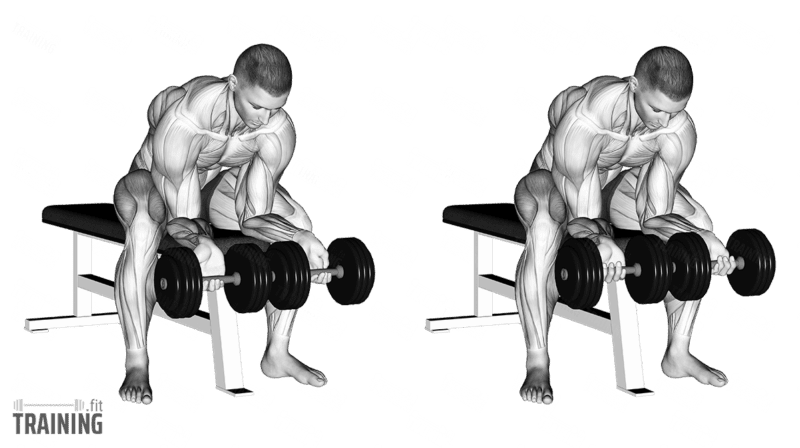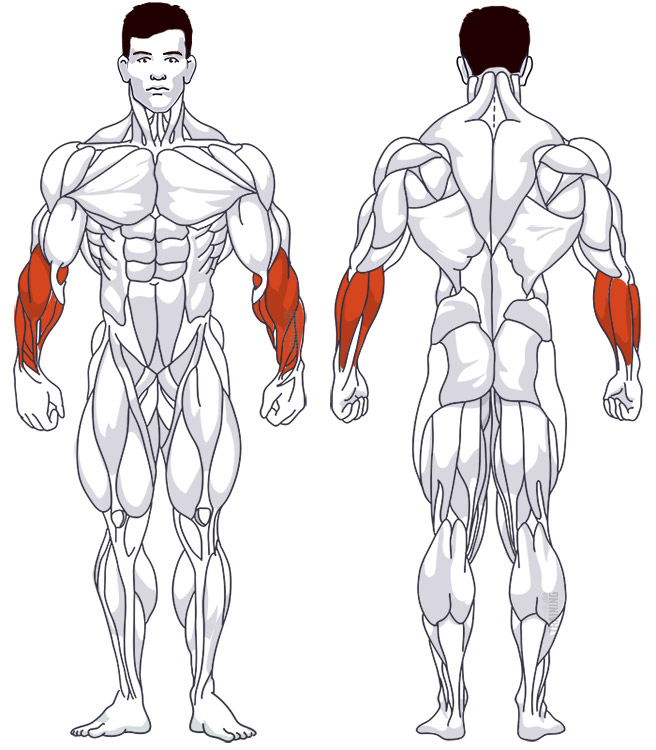Finger Curls
Isolation exercise, Free weightsOverview

Main muscles
- Forearm: Elbow muscle
(anconeus muscle) - Forearm: Finger extensor
(Musculus extensor digitorum) - Forearm: Short radial hand extensor
(Musculus extensor carpi radialis brevis) - Forearm: Long radial hand extensor
(Musculus extensor carpi radialis longus) - Forearm: Brachioradialis
(Musculus brachioradialis)
Training plans
Finger Curls is a suitable substitute for similar exercises in or as a supplement to various training plans.
Finger Curls: Basics and alternatives

Involved main muscle groups:
Finger Curls
Finger curls let you focus on training your forearms in isolation, specifically targeting your grip strength. This involves moving a dumbbell up and down across the curve of your fingers in your hand.
However, if you’re a beginner, you can usually skip isolated forearm exercises. Instead, it’s better to focus on essential exercises that work your entire body, particularly at the start of your fitness journey. Overhand grip exercises, such as biceps curls or pull-ups, can also put extra stress on your forearms without sacrificing the engagement of other muscle groups.
Correct execution
Performing finger curls is relatively simple. However, the exercise can be tricky because you don’t have a firm grip on the dumbbell for a large part of the execution. This can be uncomfortable and risky, as you might drop the dumbbell on the floor. If you’re working out at home and don’t want to damage your floor, you might want to consider other forearm exercises. Hammer grip wrist curls with the dumbbell or barbell reverse wrist curls are suitable alternatives.
It’s also recommended to perform not only finger curls but also another forearm curl exercise in the overhand grip. Finger curls target the flexors of the forearm, while the overhand grip focuses on the extensors. It’s important to train both muscle groups in a healthy balance.
Video tutorial
Step-by-step instructions
Hold the dumbbell in your hand and sit wide-legged on a flat bench.
Place the elbow of your training hand on the same side thigh (close to the knee), so the dumbbell is between your legs.
While keeping a firm grip on the dumbbell, let your wrist be loose and angle your hand downward.
Now, open your hand by moving your fingers away from the palm of your hand. Keep your fingers flexed at all times, so the dumbbell moves from the palm to your fingers.
Lower the dumbbell as far as you can, and make sure you don’t drop it on the floor.
Close your hand with the dumbbell, bringing it back towards the palm of your hand.
Common mistakes
The biggest risk with finger curls is potentially dropping the dumbbell. This can damage the floor or even cause injury if the dumbbell falls on your foot. Make sure you’re always in control of the dumbbell, even during the finger extension movement. If you can’t maintain control because the dumbbell is too heavy, use less weight.
It’s also crucial to use proper and controlled movement of the dumbbell. Avoid jerky, sweeping movements, as this can cause your wrists to hyperextend.